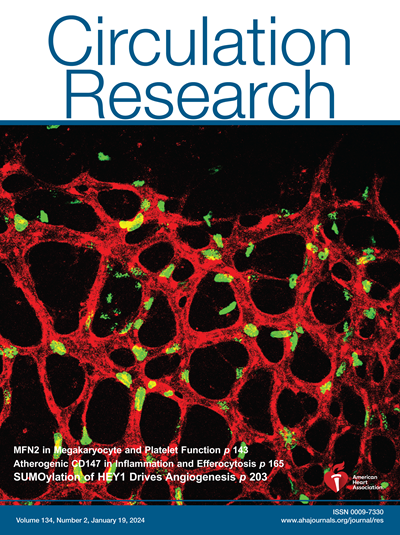Increased Intermembrane Space [Ca2+] Drives Mitochondrial Structural Damage in CPVT.
IF 16.2
1区 医学
Q1 CARDIAC & CARDIOVASCULAR SYSTEMS
引用次数: 0
Abstract
BACKGROUND Mitochondrial dysfunction caused by abnormally high RyR2 (ryanodine receptor) activity is a common finding in cardiovascular diseases. Mechanisms linking RyR2 gain of function with mitochondrial remodeling remain elusive. We hypothesized that RyR2 hyperactivity in cardiac disease increases [Ca2+] in the mitochondrial intermembrane space (IMS) and activates the Ca2+-sensitive protease calpain, driving remodeling of mitochondrial cristae architecture through cleavage of structural protein OPA1 (optic atrophy protein 1). METHODS We generated a highly arrhythmogenic rat model of catecholaminergic polymorphic ventricular tachycardia, induced by RyR2 gain-of-function mutation S2236L(±). We created a new biosensor to measure IMS-[Ca2+] in adult cardiomyocytes with intact Ca2+ cycling. We used ex vivo whole heart optical mapping, confocal and electron microscopy, as well as in vivo/in vitro gene editing techniques to test the effects of calpain in the IMS. RESULTS We found altered mitochondrial cristae structure, increased IMS-[Ca2+], reduced OPA1 expression, and augmented mito-reactive oxygen species emission in catecholaminergic polymorphic ventricular tachycardia myocytes. We show that calpain-mediated OPA1 cleavage led to disrupted cristae organization and, thereby, decreased electron transport chain supercomplex assembly, resulting in accelerated reactive oxygen species production. Genetic inhibition of calpain activity in IMS reversed mitochondria structural defects in catecholaminergic polymorphic ventricular tachycardia myocytes and reduced arrhythmic burden in ex vivo optically mapped hearts. CONCLUSIONS Our data suggest that RyR2 hyperactivity contributes to mitochondrial structural damage by promoting an increase in IMS-[Ca2+], sufficient to activate IMS-residing calpain. Calpain activation leads to proteolysis of OPA1 and cristae widening, thereby decreasing assembly of electron transport chain components into supercomplexes. Consequently, excessive mito-reactive oxygen species release critically contributes to RyR2 hyperactivation and ventricular tachyarrhythmia. Our new findings suggest that targeting IMS calpain may be beneficial in patients at risk for sudden cardiac death.膜间空间增加[Ca2+]驱动CPVT线粒体结构损伤。
背景:由RyR2 (ryanodine受体)活性异常高引起的线粒体功能障碍是心血管疾病的常见发现。RyR2功能获得与线粒体重塑之间的联系机制尚不明确。我们假设心脏病患者RyR2过度活跃会增加线粒体膜间隙(IMS)中的[Ca2+],并激活Ca2+敏感蛋白酶calpain,通过结构蛋白OPA1(视神经萎缩蛋白1)的裂解驱动线粒体嵴结构的重塑。方法建立由RyR2功能获得突变S2236L(±)诱导的高致心律失常大鼠儿茶酚胺能多形性室性心动过速模型。我们创建了一个新的生物传感器来测量IMS-[Ca2+]在成人心肌细胞完整的Ca2+循环。我们使用离体全心光学定位,共聚焦和电子显微镜,以及体内/体外基因编辑技术来测试钙蛋白酶在IMS中的作用。结果我们发现儿茶酚胺能多态性室性心动过速心肌细胞线粒体嵴结构改变,IMS-[Ca2+]增加,OPA1表达减少,线粒体活性氧释放增加。我们发现calpain介导的OPA1裂解导致嵴组织破坏,从而减少了电子传递链超复合物的组装,从而加速了活性氧的产生。IMS中钙蛋白酶活性的遗传抑制逆转了儿茶酚胺能多态性室性心动过速肌细胞的线粒体结构缺陷,减轻了体外光学定位心脏的心律失常负担。结论RyR2过度活跃通过促进IMS-[Ca2+]的增加而导致线粒体结构损伤,而IMS-[Ca2+]的增加足以激活驻留在IMS中的钙蛋白酶。Calpain激活导致OPA1蛋白水解和嵴加宽,从而减少电子传递链组分组装成超配合物。因此,过度的有丝分裂活性氧释放是RyR2过度激活和室性心动过速的关键因素。我们的新发现表明,靶向IMS calpain可能对有心源性猝死风险的患者有益。
本文章由计算机程序翻译,如有差异,请以英文原文为准。
求助全文
约1分钟内获得全文
求助全文
来源期刊

Circulation research
医学-外周血管病
CiteScore
29.60
自引率
2.00%
发文量
535
审稿时长
3-6 weeks
期刊介绍:
Circulation Research is a peer-reviewed journal that serves as a forum for the highest quality research in basic cardiovascular biology. The journal publishes studies that utilize state-of-the-art approaches to investigate mechanisms of human disease, as well as translational and clinical research that provide fundamental insights into the basis of disease and the mechanism of therapies.
Circulation Research has a broad audience that includes clinical and academic cardiologists, basic cardiovascular scientists, physiologists, cellular and molecular biologists, and cardiovascular pharmacologists. The journal aims to advance the understanding of cardiovascular biology and disease by disseminating cutting-edge research to these diverse communities.
In terms of indexing, Circulation Research is included in several prominent scientific databases, including BIOSIS, CAB Abstracts, Chemical Abstracts, Current Contents, EMBASE, and MEDLINE. This ensures that the journal's articles are easily discoverable and accessible to researchers in the field.
Overall, Circulation Research is a reputable publication that attracts high-quality research and provides a platform for the dissemination of important findings in basic cardiovascular biology and its translational and clinical applications.
 求助内容:
求助内容: 应助结果提醒方式:
应助结果提醒方式:


